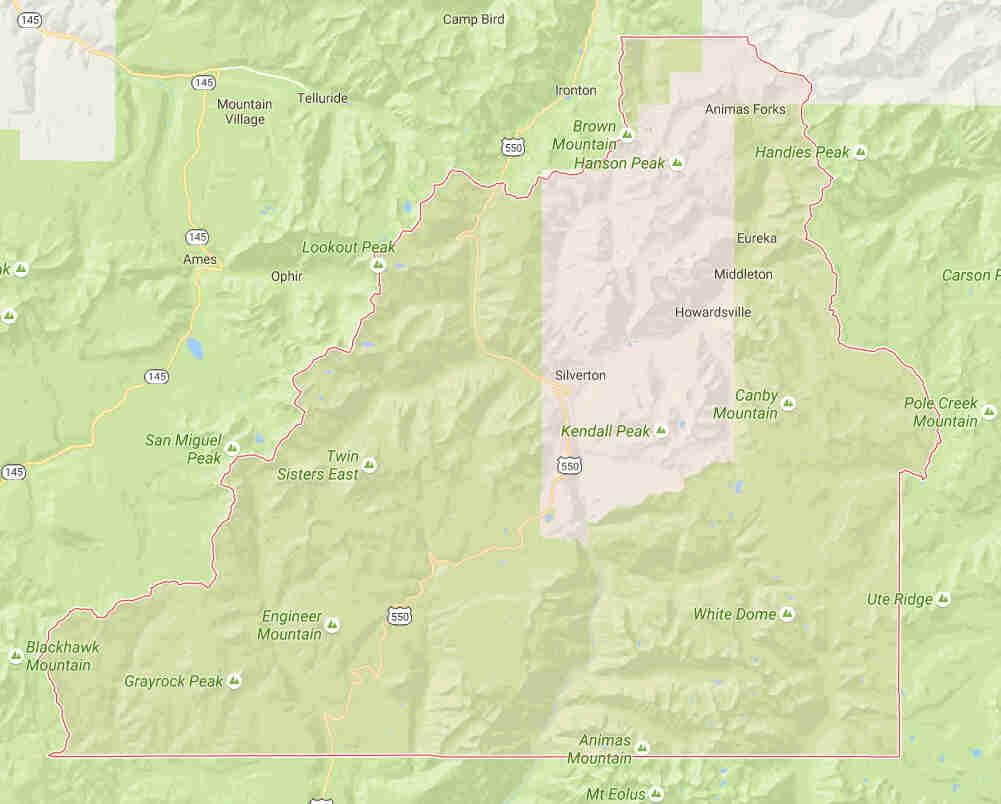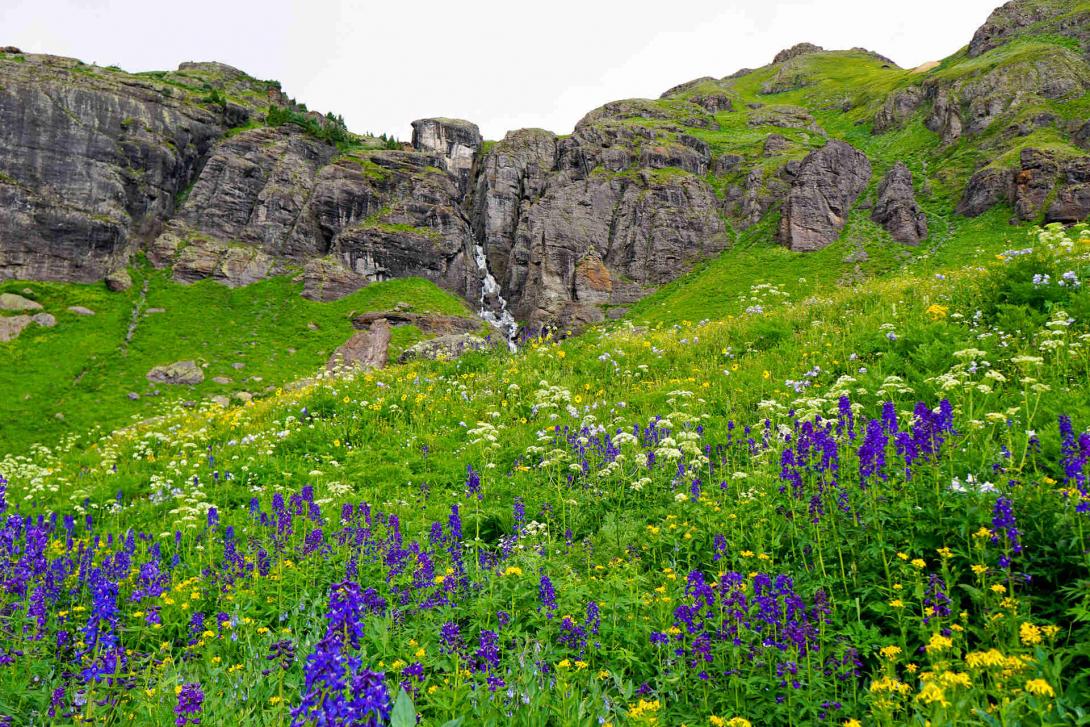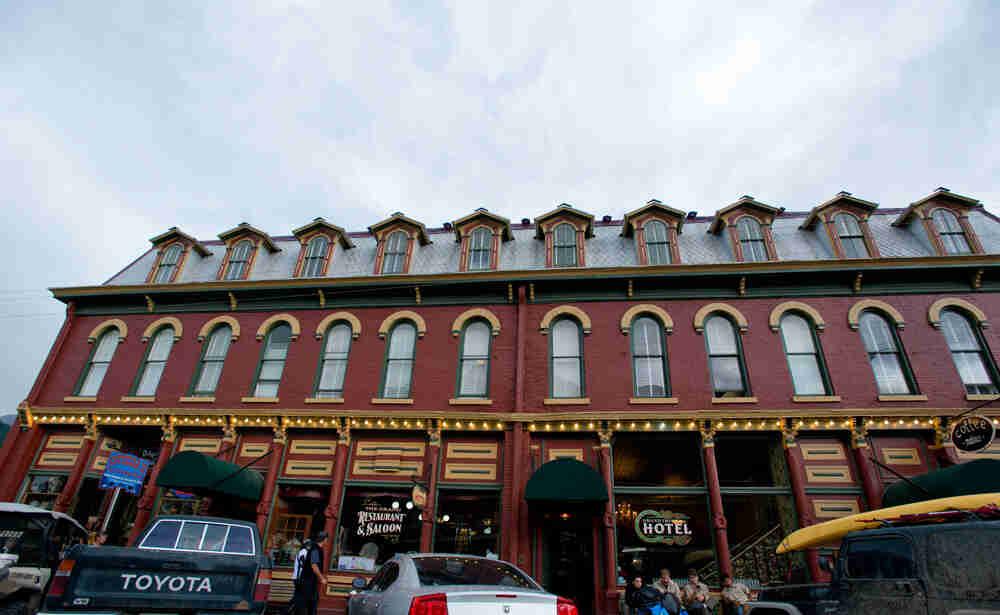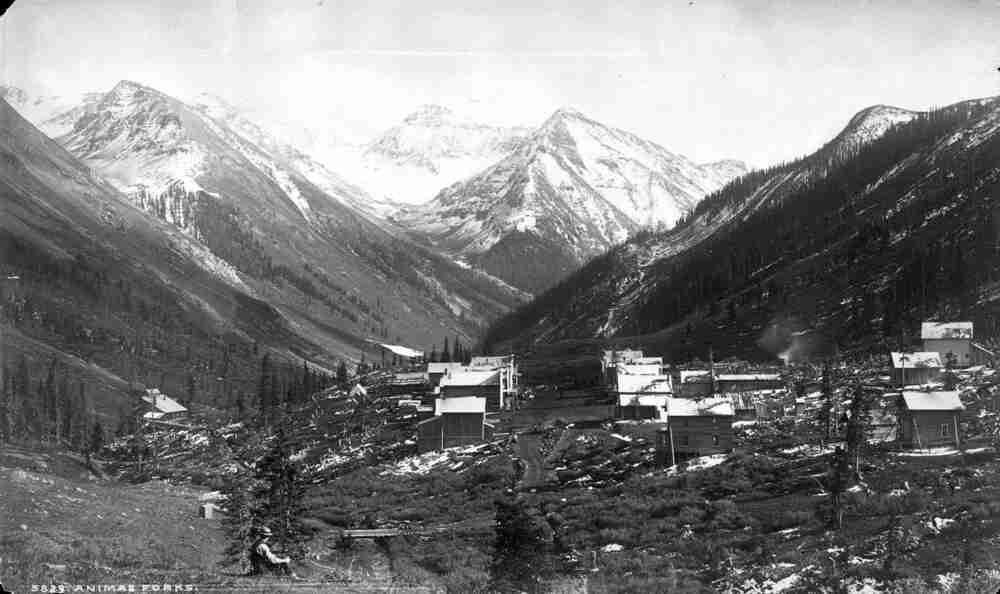San Juan County
Full Article
San Juan County was established just before Colorado became a state in 1876. It initially stretched from the Utah border in the west to its present border in the east. The next year, the first state assembly allocated most of San Juan County’s western portion to the newly formed Ouray County, and San Juan County assumed its current boundaries.
Named after the mountains within its borders, San Juan County is a remote county covering 388 square miles in southwest Colorado. With an average elevation of 11,240 feet, it is the highest county in the United States. San Juan County is bordered to the north by Ouray County, to the east by Hinsdale County, to the south by La Plata County, and to the west by Dolores and San Miguel Counties. The county is among the state’s least populous, home to an estimated 701 residents as of 2015.
As San Juan County’s only incorporated area, Silverton is the county seat, lying just off US Route 550 at the confluence of the Animas River and Mineral Creek. The highway runs north-south and splits the county into eastern and western halves. Most of the county’s land is managed by the US Forest Service as part of the 1.8 million-acre San Juan National Forest.
Utes
By 1500 the Nuche, or Ute people, occupied nearly all of Colorado’s Rocky Mountains. The San Juan County area was home to two bands of Utes: the Tabeguache (“people of Sun Mountain”), whose range extended north into the Uncompahgre and Gunnison Valleys and east to the Pikes Peak region; and the Weenuche (“long time ago people”), whose range included much of southwest Colorado, southeast Utah, and a slice of northern New Mexico.
The Nuche lived off the natural wealth of Colorado’s mountains and river valleys, hunting elk, deer, and other game and gathering a wide assortment of wild berries and roots, including the versatile yucca root. In the summer they followed game into the high country, including the San Juan County area, and in the winter they followed the animals back to the lower river valleys. By the 1640s the Utes had obtained horses from the Spanish, an acquisition that augmented their nomadic lifestyles and allowed them to organize buffalo hunts on the plains.
With the exception of the Nuche, who knew it well, the jagged and foreboding landscape of the San Juan County area was seldom traversed before the mid-nineteenth century when white prospectors encroached on their lands. The biggest obstacle to lasting peace between whites and Utes was the mineral wealth lying beneath the San Juans.
The mining endeavors along the Front Range prompted the US government to organize the Colorado Territory in 1861. That year, in an effort to stop the line of white prospectors from pushing farther west, Utes burned Animas City, the small cabin town of north of Durango that served as the staging point for prospecting parties. In 1868 the US government and several Ute bands, including the Tabeguache under Chief Ouray, signed a treaty that ceded the Front Range and central Rockies to the United States and left the Utes a vast reservation encompassing nearly the entire Western Slope.
The “San Juan Humbug”
The prospector Charles Baker is regarded as the first white American to enter the San Juan County area. Baker arrived in Colorado during the Colorado Gold Rush of 1858–59 only to find the best deposits already claimed. Determined to find his own cache of Rocky Mountain riches, Baker and a small party of gold seekers set out to southwest Colorado in 1860.
After failing to find gold along the Gunnison River, they pushed into the San Juans. At a spot in the Animas River valley where multiple streams converged, a number of small deposits sufficiently whetted the prospectors’ mineral appetites. In October Baker came out of the mountains for supplies and to recruit more prospectors to the place he now called “Baker’s Park.” In mid-October Baker returned to the Animas Valley with 150 new prospectors. The newcomers had just enough time to scout out claims, pan for gold, and head back to the safety of lower elevations before the deep winter snows arrived.
Over the winter, news of the San Juan gold discovery raced across the Rockies to the Front Range, where the size of the find was greatly exaggerated. Hundreds more prospectors were enticed to make the trip to Baker’s Park the following spring. Knowing this, Baker and his group were anxious to return to the area first and headed up to the Animas Valley in April 1861. A group led by S. B. Kellogg had beaten them there, but Kellogg’s men followed frontier-mining etiquette and waited for the discoverer to arrive before staking their own claims.
But once Baker arrived he did not immediately stake his claims, and the snow soon began to mount. As the weather worsened, it quickly became clear that all parties had made their ascent prematurely. Many in the camp began to seriously fear being trapped, and to avoid that fate—or a mutiny beforehand—Baker hastily staked his claims over what he remembered to be the best areas. The rest of the prospectors quickly staked their claims and made a rapid descent.
In May and June 1861 about 600 miners flooded into Baker’s Park. With most of the good claims already staked by Baker and the others earlier that year, many of these prospectors came up empty-handed. In their frustration, some even contemplated hanging Baker, but most left in despair. Before the year ended, Baker, Kellogg, and the rest of the initial prospectors also left, finding the actual amount of gold to be far less than expected. The rapid sequence of discovery, hype, and bust in Baker’s Park produced so much discontent that it became known as the “San Juan Humbug.”
Early Mining
The year 1870 brought an end to the lull in mining activity in the San Juan County area. In April a party led by Adnah French, Dempsey Reese, and Miles T. Johnson reoccupied some of the cabins of the burned-out Animas City. The group prepared to scout Baker’s Park for hardrock ore—the source of the nuggets that gave the gold-panning Baker party a taste for wild riches.
Within weeks French’s group found that gold source, which they began extracting via the Little Giant mine, as well as several veins of silver. The party left Baker’s Park late that summer, wintered in New Mexico, and returned in May 1871 to develop the Little Giant mine with the help of carpenters William J. Mulholland and Thomas Blair and the merchant James H. Cook. The team made the Little Giant into the first profitable mine in the San Juan County area.
More successful strikes followed, and by the summer of 1872 gold and silver ore worth some $30,000 per ton was being carved out of the San Juans. The riches flowing out of the mountains prompted Colorado territorial governor Edward McCook to openly lament the 1868 treaty that barred nonnatives from the mountains. For its part, the US government responded by ordering miners to leave Ute lands, and even sent in troops to enforce the treaty. The miners, however, banded together before any conflict took shape and convinced the government to negotiate a new treaty that would take more land from the Utes.
Brunot Agreement
The Brunot Agreement of 1873, also known as the San Juan Cession, cleared the way for present-day San Juan County by removing the people who had lived there for more than four centuries. The government coveted a rectangular chunk of the San Juan Mountains that measured 4 million acres and that included most of what is today southwest Colorado. In 1873 Felix R. Brunot, then-president of the US Board of Indian Commissioners, hatched a plot to find Ouray’s lost son Pahlone, believed to be in Arapaho possession, and trade him to the chief for the land.
Although Brunot’s men could not find Ouray’s son, at negotiations in September Ouray still wanted to provide for his wife and was impressed enough by Brunot’s effort that he agreed to sell the San Juans to the United States. The river valleys suitable for farming were supposed to remain in Ute possession, but the final agreement was struck along lines of latitude and longitude—a concept the Utes were not familiar with—so the United States got all 4 million acres. The government paid the Utes seven and a half cents per acre, a poor deal considering that it simultaneously charged white homesteaders $1.25 per acre for other, grossly inferior land. Following the Meeker Incident, a Ute uprising in northwest Colorado, most of the state’s Ute population was expelled to a reservation in Utah by 1882.
County Development
Silverton was established in 1874 as one of dozens of mining camps that sprung up in the San Juans during the mid-1870s. As the center of regional mining activity, Silverton developed quickly in the early 1880s. The first church was built in 1881. Its future as a viable town, much less as county seat, was anything but certain. In fact, the territorial legislature initially gave the county seat to a rival camp, Howardsville. But the first Silverton residents convinced the owners of a smelter and sawmill to set up shop, and those key services turned Silverton into a hub for San Juan County miners. Its residents went a step further and organized an election to redetermine the county seat. Silverton won, snatching the county seat from a dwindling Howardsville in 1874.
North of Silverton, the small town of Animas Forks grew out of a cluster of cabins when it gained a US post office in 1875. The Dakota and San Juan Mining Company built a mill the next year, and the town soon had three general stores, a butcher, restaurant, a saloon, and two boardinghouses.
Additional smelters built in 1874 proved to be woefully inefficient, extracting only a paltry amount of metal from the county’s rich ore. A combination of inadequate smelters and rich silver strikes elsewhere in the state staved off investment in San Juan County mines until 1875. That year, metallurgist John A. Porter refitted and improved the smelter owned by Greene & Company, one of the early developers of Silverton. Soon, a second smelter was in operation, and with its revived smelting capacity the county was almost ready for its long-awaited boom. The final piece was the arrival of the Denver & Rio Grande Railroad, which connected Silverton to the smelters in Durango in 1882.
Mining Boom
Mining activity had already increased after the smelters were fixed; for instance, Leadville silver baron Horace Tabor purchased several San Juan County mines in 1879. But the railroad galvanized production because it drastically reduced the costs of shipping ore to smelters and metal to market. In 1882 productive mines opened on Sultan Mountain just southwest of Silverton, forming the prosperous Mineral Creek District. Other productive mines were set up on Kendall Mountain southeast of Silverton and in the Eureka District to the northeast. By 1886 there were 102 mines in San Juan County, double the amount in 1882. In 1882 county mines produced $53,000 in silver, $10,000 in gold, and $16,000 in lead, but by 1885 those values had climbed to $749,000 in silver, $40,000 in gold, and $207,000 in lead.
At this time San Juan County was also the main entry point to the mines of the Red Mountain District in neighboring Ouray County; the town of Chattanooga, which was formed through the merger of two mining camps in northern San Juan County, supplied the district. In 1882 metallurgist Cushing M. Bryant opened Bryant’s Mining Exchange, a business center that served the area’s mining investors, and in 1883 the San Juan County Bank was chartered as the First National Bank of Silverton. Silverton also became the cultural center of the San Juans, featuring thirty saloons, two dance halls, a community performance and celebration house, and several men’s and women’s clubs.
Bust and Recovery
In 1887 the miner Olaf A. Nelson located and staked the Gold King claim north of Silverton on the north fork of Cement Creek. The Gold King Mine, one of the richest in San Juan County history, began operating in 1893. The Gold King had scarcely begun operations when the Silver Panic of 1893 caused the price of silver to drop to an all-time low of seventy-eight cents per ounce. The initial effect on the San Juan County economy was devastating—nearly 1,000 of the county’s 1,600 people lost their jobs.
But by 1896, as most Colorado mining regions failed or languished in economic depression, several factors allowed San Juan County to make a miraculous recovery. First, the remaining mines, especially the largest ones, were still producing enough ore to keep local and regional smelters in business. Second, that ore was exceptionally rich, often containing both gold and silver. Finally, the county’s wealthiest investors, such as mine owner Edward G. Stoiber and road builder Otto Mears, poured large sums of capital into mine expansion, road maintenance, and railroad construction in order to keep their operations viable. The result of all this was a dramatic increase in production in 1896. By then several shuttered mines had reopened and existing mines such as the Gold King had expanded. That year the county produced a remarkable $1.5 million in silver, $909,000 in gold, and $169,000 in lead.
Though it was subject to ups and downs, mining remained the most important part of the San Juan County economy through the beginning of the twentieth century. By the end of World War I, county mines had produced more than $60 million in gold, silver, copper, lead, and zinc.
Labor Strife
The mining revival led to an uptick in the San Juan County population by 1900, but not all of the county’s 2,342 residents were content. Workers in the mines, smelters, and mills worked grueling, ten-hour shifts in dangerous conditions, and by the late nineteenth century many joined unions that lobbied for higher wages and a shorter workday. The county narrowly avoided a wave of strikes occurring across the state in 1899, but in 1907 tensions between miners and mine owners resurfaced as the economy dipped again. Budget-wary mine owners looked to cut labor costs, but miners threatened to strike and won a three-dollar, eight-hour workday.
Labor strife returned to the county in 1939, when Charles Chase—owner of the Shenandoah-Dives, the county’s largest mine—sought concessions from his workforce. Miners and mill workers refused and shut down the mine with a strike in June. But Chase’s company was backed by wealthy investors, which allowed him to wait out the strike. The summer-long strike ended in a stalemate, as workers voted to return to work with no concessions.
Mining continued in San Juan County through World War II but began tapering off in the 1960s. The county’s last significant mine, the American Tunnel, closed in 1991.
Durango-Silverton Railroad
In addition to being the primary carrier of San Juan County ore, the Denver & Rio Grande Railroad line connecting Durango and Silverton was promoted as a tourist route from its opening in 1882. The railroad persevered through multiple economic and natural challenges, having to reduce service during the 1890s depression and reorganize following government control during World War I. In addition, the line traversed some of the most challenging terrain in the Rocky Mountains and had to constantly contend with rockslides, avalanches, and blizzards. After World War II the railroad was in danger of folding, but staff turned its promotional efforts toward tourism, and Hollywood directors shot a number of films along the route, including the 1956 film Around the World in 80 Days. During the 1980s, the railroad replaced more than 10,000 ties and began weathering its cars for winter use. The Durango-Silverton Railroad remains a major attraction today, with vintage, coal-fired locomotives carrying trainloads of tourists year-round through the majestic scenery of the San Juans.
Today
Though it is the main tourist attraction, San Juan County’s natural environment continues to struggle with the toxic legacy of mining. Mining exposes mineral-laden rock to oxygen, facilitating a chemical process in which metals liquefy and leech into local watercourses. This process, known as Acid Mine Drainage, has been occurring in San Juan County mines since they opened and continues to cause problems today. In August 2015 workers for the US Environmental Protection Agency (EPA) accidentally released some 3 million gallons of contaminated water from the abandoned Gold King Mine into the Animas River, coloring huge stretches of the river a metal-tainted orange. Even though the EPA caused the spill, Silverton and San Juan County officials voted in February 2016 to pursue EPA Superfund status in order to clean up forty-six mines and two settlement areas in the county. Even though it now has the county’s approval, the EPA will need to conduct research for several years before cleanup can begin.





































